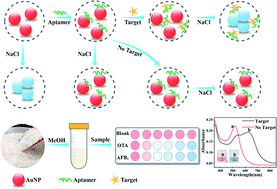Gold nanoparticle-based colorimetric aptasensor for rapid detection of multiple mycotoxins in rice†
Abstract
A novel, simple and rapid colorimetric aptasensor for multiple mycotoxins (ochratoxin A (OTA) and aflatoxin B1 (AFB1)) detection was developed using unmodified gold nanoparticles (AuNPs). In the work, the high affinities of OTA and AFB1 aptamers were employed as the recognition elements for the colorimetric determination of OTA and AFB1. In the absence of mycotoxins, the sulfhydryl-modified aptamers were directly adsorbed to the AuNP surface through Au–S bonds, further prohibiting the aggregation induced by a high concentration of salt, and the solutions remain red. In the presence of mycotoxins, the corresponding aptamer–target complexes were formed and the corresponding aptamers were detached from the surface of AuNPs, leading to the aggregation of AuNPs under the optimal salt solution and a color change. By spectroscopic quantitative analysis and visual analysis, the LODs of OTA and AFB1 were down to 0.005 ng mL−1 and 0.07 ng mL−1, respectively. Furthermore, the colorimetric aptasensor showed a high specificity in the presence of other interfering mycotoxins and metal ions. Finally, the developed aptasensor was applicable to detect OTA and AFB1 in rice samples with satisfactory performance. Our strategy has great potential for the rapid and sensitive detection of OTA and AFB1 for on-site analysis.



 Please wait while we load your content...
Please wait while we load your content...